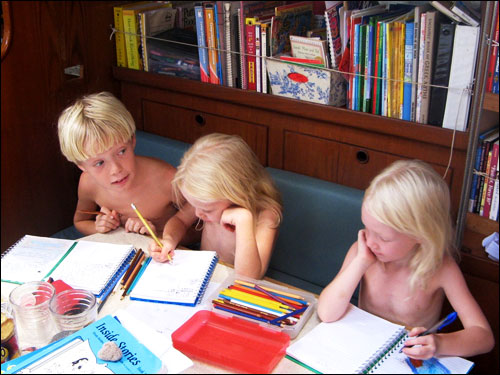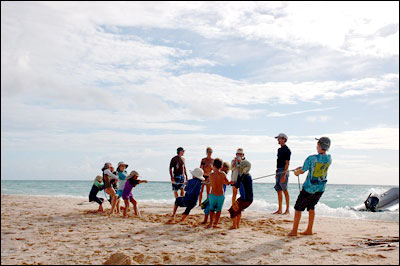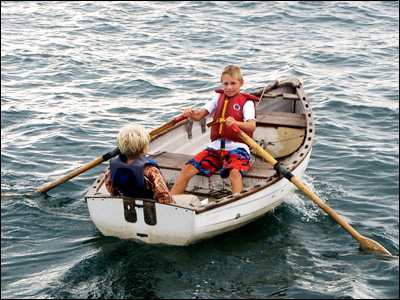8. How do you handle: EDUCATION and FULFILLMENT?
Schooling
 |
The children, journaling in TOTEM’s main cabin |
On s/v Totem, we take an eclectic approach to homeschooling. The most important part of education for us is to embrace and learn from the environment around us. Instead of buying boxes with a school-year-in-a-box, we stuffed our boat with resources for FUN, and to support learning from the world around us.
A great microscope for looking at critters from the land and the sea... stories and references about the countries we visit, the animals we see, the natural environment we experience... games we play as a family and books, books books!
We do have some traditional educational tools (a math program, some spelling workbooks, etc.) but let the interest of our children be the number one driver in directing their education. We don't have a strict daily structure; we try to grab those times when the children are most excited and interested in something, which makes for natural (and much more fun) learning.
If conditions are benign, we find passages are a great time to pull out the books - counterpoint to the environmental learning that tends to happen in a new location. After two years, it is a joy to see them growing as articulate children of the world through our untraditional approach to learning afloat.
Friendships and social interactions
 |
Beach games ensue with a gathering
of “kid boats”
in the Tuamotus |
 |
Playdates in Paradise
Timothy (s/v Whisper) picks up Niall in the dinghy |
There are so many other boats with children out cruising right now, it's easy to find playmates.
There's an important shift that takes place in cruising kids, where they are no longer pigeonholed into highly specific groups based on age and often gender: they are accustomed to having playmates across a range of ages and could care less if they're boys or girls.
Just yesterday, we had a baseball game in a palm grove with a 7 year age range across the kids participating.
We've routinely shared anchorages with 3 or more boats that have children on board, and several times this year been with 8 or more “kid boats.”
Keeping the kids entertained
They don't need us to entertain them…I like to think of this as one of the false needs of modern families that we've left behind. Our kids have no trouble entertaining themselves; by the same token, we all have a good time playing together. Personal space aboard
Our girls currently share the v-berth, and our son sleeps the bunk-bed cabin aft of theirs; we have the aft cabin, and some separation from the kids with our main living space between. Space for the children was a significant factor in our choice of cruising boat.
In our old boat, an Hallberg-Rassy 35 (aft master, v-berth forward), the kids were happy puppy-piling into the master bunk, the v-berth, and/or the settees. They were also that much younger, and weren't living aboard at the time. Still, it didn't seem like a viable long term layout for our family.
We felt it would be important for the girls and our son to have separate cabins as they edge toward adolescence, and enough space to call their own.
It's hard to find a layout in an offshore monohull that accommodates this in less than 50', and is one of the reasons we decided that the Stevens 47 was perfect for us. Some boats are able to make the shared v-berth work for boy-girl siblings by hanging a curtain or otherwise creating some separation, but we don't know any teenagers currently in this situation. Frankly, I don't think it's workable for longer term cruising.
Family back home and their concerns
We try to be open and frank with our families about what we're doing.
They don't all agree and we don't have full support but we do at least have acceptance. We try to impress on them our realistic ability to keep in touch - especially when we may not be able to update them for a period of time, to set the right expectations so there are no false alarms based on unfounded concerns about our whereabouts. |